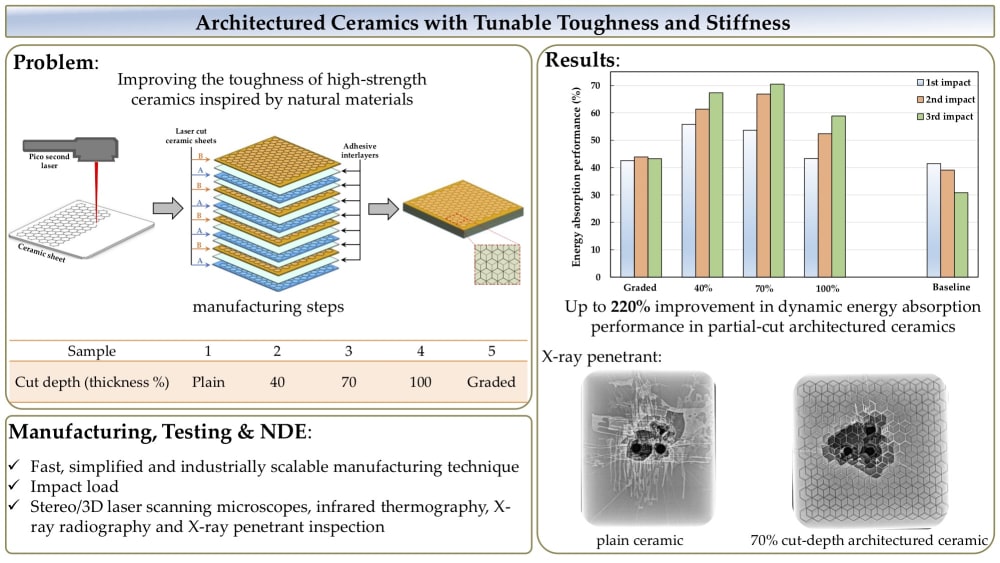

Ceramics have been integral in the aerospace industry due to their low-density, high compressive strength and thermal stability. However, their range of applications currently remains limited due to their generally brittle fracture behavior. Structures in nature, such as mollusk shells and enamels, have unusual combinations of stiffness, strength, and toughness, overcoming the brittleness of these materials. This is achieved via novel architectures consisting of brittle components combined with weaker interfaces which change their mechanical response. Cracks are channeled along these weak interfaces until additional mechanisms prevent further propagation. New frontiers in manufacturing (such as additive or subtractive manufacturing) can enable the application of these bio-inspired strategies into structural ceramic materials.
We have developed a fast, simplified and industrially scalable fabrication technique based on laser machining for large-scale architectured ceramics. Utilizing this technique, a new class of advanced ceramics based on bio-inspired architectures have been designed to improve and tune the mechanical response in multi-impact conditions. The multilayered ceramics were manufactured by stacking laser-cut hexagonal tiles (with differing cut depths) and interlayers made of the commercial monomer Surlyn®.
Stereo/3D laser scanning microscopes and nondestructive evaluation (NDE) techniques including infrared thermography, X-ray radiography and X-ray penetrant inspection were used to assess the architectures before and evaluate the multiscale damage after each impact. It was found that the multilayered architectured ceramic systems with a partial-cut depth (i.e., 40% and 70%) exhibited higher dynamic energy absorption performance (up to 220% for the 3rd impact) and higher stiffness (up to 80% for the 3rd impact) than the multilayered plain ceramic. The results showed a bell-shaped response in the partial-cut architectured ceramics, indicating tough materials (opposed to the plain one) and superior multi-hit resistance owing to the energy dissipation mechanisms including plastic deformation in adhesive interlayers and inter-cuts, crack deflection, frictional energy dissipation due to tile sliding (absent toughening mechanisms in the plain system) as well as ceramic fracture upon flexural cracks in the partial-cuts and delamination crack (absent mechanisms in the 100% cut-depth architectured system).
Novelty of the ceramics with architectured structures offers a unique opportunity to collaborate with universities and to generate IP. Upon the demonstration of the concept, multifunctional architectured ceramics could be used in aerospace, energy, and defense sectors. The applications can consist of personnel armor with multi-hit capability, thermal protection systems and propulsion components. Gas turbines have an essential role in the global energy markets and any improvement in their efficiency has a significant environmental and economic impact. This project would be addressing a current need for companies like Rolls Royce, Pratt and Whitney, and Siemens.
-
Awards
-
 2021 Aerospace & Defense Honorable Mention
2021 Aerospace & Defense Honorable Mention -
 2021 Top 100 Entries
2021 Top 100 Entries
Like this entry?
-
About the Entrant
- Name:Hamidreza Yazdani Sarvestani
- Type of entry:teamTeam members:Behnam Ashrafi
- Software used for this entry:ANSYS, ABAQUS
- Patent status:none





